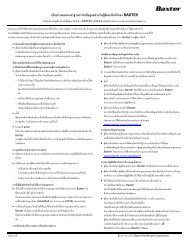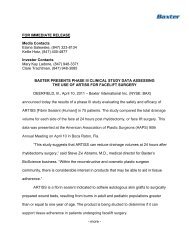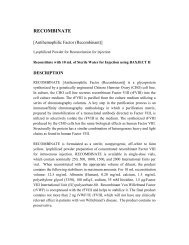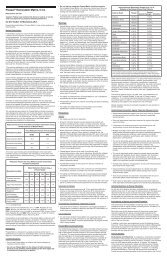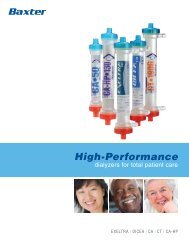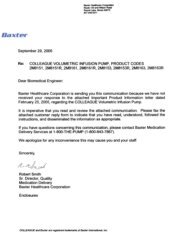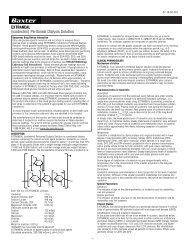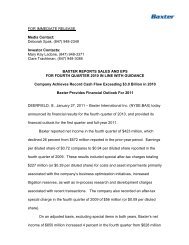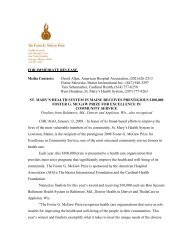4% Icodextrin - Baxter
4% Icodextrin - Baxter
4% Icodextrin - Baxter
You also want an ePaper? Increase the reach of your titles
YUMPU automatically turns print PDFs into web optimized ePapers that Google loves.
Table 2: Pivotal Study Most Frequent Adverse Events<br />
(i.e. those reported by at least 5% of patients in either group,<br />
regardless of causality) – Intention-to-Treat (ITT) Population<br />
ADEPT ® LRS<br />
Number of Number of Number of Number of<br />
patients reporting reports patients reporting reports<br />
Total number of<br />
patients at risk<br />
227 222<br />
Post procedural pain 192 (84.6%) 223 194 (87.<strong>4%</strong>) 233<br />
Headache 81 (35.7%) 131 72 (32.<strong>4%</strong>) 127<br />
Nausea<br />
Leaking from Port<br />
39 (17.2%) 41 37 (16.7%) 41<br />
Sites Post-procedure 31 (13.7%) 31 30 (13.5%) 30<br />
Dysmenorrhea 30 (13.2%) 32 26 (11.7%) 34<br />
Constipation 24 (10.6%) 26 23 (10.<strong>4%</strong>) 24<br />
Pelvic pain 23 (10.1%) 32 21 (9.5%) 21<br />
Arthralgia 20 (8.8%) 22 19 (8.6%) 19<br />
Flatulence 19 (8.<strong>4%</strong>) 19 17 (7.7%) 19<br />
Urinary tract infection 16 (7.0%) 17 12 (5.<strong>4%</strong>) 13<br />
Abdominal pain 15 (6.6%) 26 19 (8.6%) 23<br />
Dysuria 15 (6.6%) 16 8 (3.6%) 9<br />
Nasopharyngitis 15 (6.6%) 15 18 (8.1%) 18<br />
Vaginal bleeding 14 (6.2%) 15 5 (2.3%) 5<br />
Abdominal distension 13 (5.7%) 13 10 (4.5%) 10<br />
Post procedural nausea 13 (5.7%) 13 20 (9.0%) 20<br />
Pyrexia 13 (5.7%) 13 7 (3.2%) 7<br />
Vomiting<br />
Labial, Vulvar or<br />
13 (5.7%) 13 22 (9.9%) 22<br />
Vaginal swelling 13 (5.7%) 13 1 (0.45%) 1<br />
Back pain 12 (5.3%) 15 12 (5.<strong>4%</strong>) 13<br />
Insomnia 12 (5.3%) 14 8 (3.6%) 8<br />
Cough 10 (4.<strong>4%</strong>) 10 12 (5.<strong>4%</strong>) 13<br />
Diarrhea 3 (1.3%) 3 13 (5.9%) 15<br />
In the pivotal study, the most frequently occurring (report incidence as % of number of patients)<br />
treatment-related adverse events between surgeries were post procedural leaking from port sites,<br />
labial, vulvar or vaginal swelling and abdominal distension.<br />
IV. CLINICAL STUDIES<br />
ADEPT ® has been studied in the USA in two pilot studies and one doubleblind,<br />
pivotal study in female patients undergoing gynecological laparoscopic<br />
surgery with a planned second look laparoscopy. The studies were<br />
conducted to evaluate the safety and effectiveness of the device as an adjunct<br />
to good surgical technique in the reduction of post-surgical adhesions in<br />
comparison to (LRS). ADEPT® or LRS was used as an intra-operative<br />
irrigant (100 mL every 30 minutes) in all studies; in the pivotal study, 1L of<br />
ADEPT® or LRS was instilled into the peritoneal cavity at the end of the<br />
surgical procedure. In the pilot studies, 1L in the first study and up to 2L in<br />
the second study were instilled at the end of surgery. In all three studies, the<br />
incidence, extent and severity of adhesions were assessed at 23 prospectively<br />
determined anatomical sites, using established adhesion scoring methods<br />
at baseline surgery (prior to adhesiolysis) and at second look laparoscopy.<br />
Safety was evaluated based on adverse events and clinical laboratory tests.<br />
For both pilot studies, second look laparoscopy took place 6-12 weeks after<br />
the initial surgery. In both of these studies, there was a greater reduction in<br />
the number of sites with adhesions, and the extent and severity of adhesions<br />
in the ADEPT® subjects compared to the LRS subjects. However, these<br />
differences were not statistically significant, which may be due in part to the<br />
relatively small numbers of subjects in these studies.<br />
PIVOTAL STUDY<br />
The pivotal study was a comparative, double-blind, randomized, multicenter<br />
study in the USA. A total of 449 female patients aged eighteen or over were<br />
enrolled for whom laparoscopic peritoneal cavity surgery was planned for a<br />
gynecological procedure which included adhesiolysis and who agreed to<br />
undergo second look laparoscopy as part of their treatment plan at 4-8 weeks<br />
after the initial surgery. The patients had to have adhesions at three or more<br />
of the 23 pre-specified anatomical sites and adhesions at three or more of the<br />
anatomical sites had to be lysed during the surgery.<br />
Objectives<br />
The study objectives were to determine the effectiveness and safety of<br />
ADEPT® when used as an intraoperative washing solution with a<br />
postoperative instillate in the reduction of post-surgical adhesions after<br />
laparoscopic surgery for adhesiolysis, compared with LRS.<br />
Inclusion Criteria:<br />
• willing, able to and having freely given written consent to participate<br />
in the study and abide by its requirements;<br />
• female patients aged eighteen and over, in good general health<br />
including ASA (American Society of Anesthesiologists ) score of<br />
2 or less;<br />
-4-




